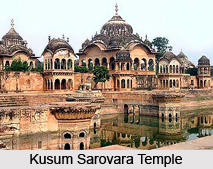 History of Mathura covers with the myths on Lord Krishna. This ancient city in Uttar Pradesh came into existence from the time of early Vedic period. This place of ancient historical beauties is mentioned in Ramayana and Mahabharata, the Indian epics.
History of Mathura covers with the myths on Lord Krishna. This ancient city in Uttar Pradesh came into existence from the time of early Vedic period. This place of ancient historical beauties is mentioned in Ramayana and Mahabharata, the Indian epics.
Mathura is related with stories of Lord Krishna, his birth and the part of his life he spent there with Radha, the consort of Iyan Ghosh.
Mythological History of Mathura
Once, there was king named Ugrasena, who ruled over Mathura. Once Ugrasena and his wife were taking a walk in the gardens when a demon saw the queen and fell in love with her. In his desire for the queen he diverted Ugrasena, assumed his form. From there, a child was born of this union was Kansa. Kansa grew up and dethroned his father and imprisoned his cousin, Devaki. While driving Devaki and her husband Vasudeva in his chariot, Kansa heard a voice in the sky (akashvani) telling him that he was carrying a woman whose eighth child would kill him. Kansa immediately prepared to till Devaki. But Vasudeva arbitrated and begged for her life. Vasudeva promised to Kansa that they would hand over all their children to him soon after their birth. So Kansa imprisoned them and killed seven children.
 Early History of Mathura
Early History of Mathura
Before the advent of Gautama Buddha and his philosophy, the place where Mathura is located was called Surasena. It was 6th Century BC. In Buddhist literature, Mathura is called Madhura. It was also known as "Mathera". Mathura was a prosperous city and the capital of a large territory. A Buddhist centre was established in Mathura during the reign of the Maurya dynasty. This centre existed for a few centuries. Emperor Ashoka made many Buddha stupas in Mathura on the bank of the Yamuna River. Kanishka, the Saka Emperor in the first century BC and his successors constructed many Buddhist stupas and chaityas to foster the Buddhist philosophy in that region.
In the early times, Mathura was the largest city in North India. Mathura was serving as the capital city for the area for administration. During these times the present town of Vrindavana was the dense forest. In the beginning of the 5th century AD the Chinese traveller Fahien saw 20 Buddhist monasteries and 3000 Buddhist priests living in Mathura. By the middle of the 6th century AD Buddhism started to decline in the Mathura area. Many Buddhist relics have been found in the Mathura area.
Medieval History of Mathura
The Sultan of Delhi, Mahmud Ghazni invaded Mathura in 1018. He plundered many buildings and temples in Mathura. It took his men 20 days to plunder the city. He took 5,000 prisoners and took over 30 million rupees. He took so many statues of gold and silver and jewellery that it took over 100 camels to carry everything that he took. Tarikhi Jamina wrote a record of Mahmud Ghazni in which he described Mathura at the time that it was attacked.
 During his rule, Pherose Khan Jughalak, who ruled from 1351 to 1388, destroyed all the Hindu temples that were within the territory that he ruled. While he ruled no one was allowed to go on pilgrimage to holy places or allowed to bath in a sacred place. From the eleventh century until the end of the sixteenth century temples in Braja were periodically destroyed. Sikandar Lodi, who ruled from 1488 to 1516 first duty after conquering a place was to destroy all the temples there. He attacked Mathura in 1500. Indian Sufi saint, Chaitanya visited Vrindavan in 1514 during the rule of Sikandar Lodi.
During his rule, Pherose Khan Jughalak, who ruled from 1351 to 1388, destroyed all the Hindu temples that were within the territory that he ruled. While he ruled no one was allowed to go on pilgrimage to holy places or allowed to bath in a sacred place. From the eleventh century until the end of the sixteenth century temples in Braja were periodically destroyed. Sikandar Lodi, who ruled from 1488 to 1516 first duty after conquering a place was to destroy all the temples there. He attacked Mathura in 1500. Indian Sufi saint, Chaitanya visited Vrindavan in 1514 during the rule of Sikandar Lodi.
Modern History of Mathura
The region of Mathura was added to British territory in 1803. Till 1832, when Mathura was recognised as district, the region was partly administered from Agra and partly from Sadabad. The land of Braj starts from Kotban near Hodel about 95 km from Delhi and ends at Runakuta which is known specially for its association with the poet Surdas, an ardent devotee of Lord Krishna devotee long line of picturesque Ghats - with their steps leading to the water`s edge, arched gateways and temple spires extending along the right bank of the Yamuna River, emphasise the sacred character of the town of Mathura.



















